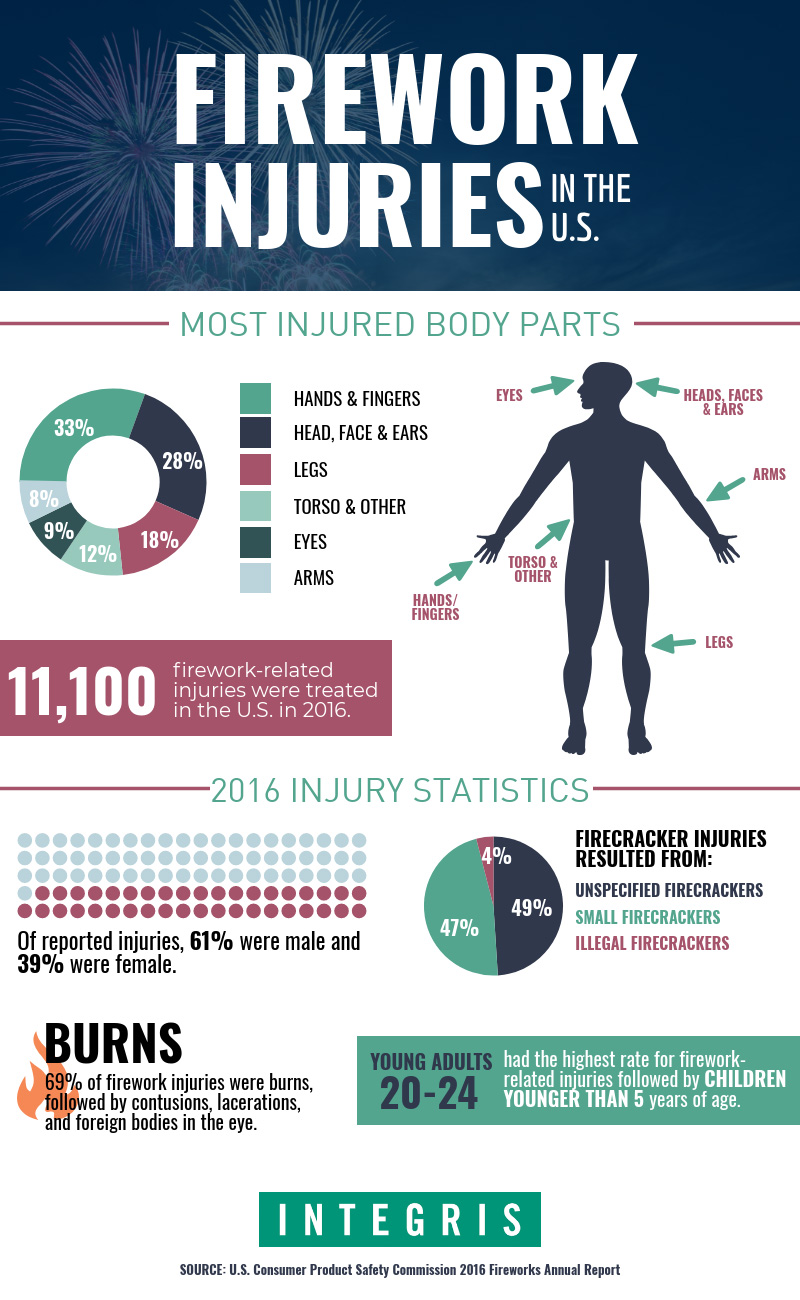Areas of the Body Most Injured by Fireworks

Fireworks are likely a part of your Fourth of July celebration, but that doesn’t mean they are safe! The Consumer Product Safety Commission (SPSC) estimates an average of 250 people make a trip to the emergency room each day of the month with a firework-related injury around the holiday. What areas of the body get the most damage?
Fireworks of any kind are dangerous. Even sparklers, which many parents think are safe, burn at almost 2,000 degrees Fahrenheit, which can melt metal. When something goes awry with fireworks, they can cause serious burns, eye injuries, hand injuries and even death.
INTEGRIS hand surgeon Dr. Ghazi Rayan is past president of the American Society for Surgery of the Hand, a medical association of more than 4,000 hand surgeons and therapists dedicated to hand and upper extremity surgery. Dr. Rayan sees many patients with hand injuries caused by fireworks. He says, "Finger and hand injuries are particularly difficult to treat because they involve both burns and blast injuries. Fireworks can damage tissues from the skin though the bone and can even cause partial or complete hand amputation."
That’s why it’s illegal to buy, sell or discharge fireworks without a permit in many cities in Oklahoma. As your family celebrates Independence Day, make safety your number one priority. We’ve compiled information on the most common firework-related injuries, how to care for firework burns and how to operate fireworks safely, if you are in an area that allows legal use of them.
Common firework injuries
Injuries from fireworks are very common and the majority involve the same areas of the body. “The most frequently injured body parts are the most valuable things to a human — the eyes, face, hands and fingers,” says Dr. Christopher Lentz, who is medical director of the INTEGRIS Burn Center. At INTEGRIS, Dr. Lentz estimates the hospital receives 40 to 50 calls an hour from 9 a.m. to 1 a.m. on the July 4th holiday.
The CPSC reports that fireworks caused more than 11,000 injuries in 2016, with burns making up 69 percent of them.
- 33 percent of injuries involved the hands or fingers.
- 28 percent were injuries to the head, face and ears.
- 18 percent involved the legs.
- 9 percent involved the eyes (contusions, lacerations and foreign bodies in the eyes were most frequent).
- 8 percent involved the arms.
- 12 percent involved the torso or other body parts.
“I’ve seen the entire gamut of injuries,” says Dr. Lentz. “Burns from handling sparklers, clothes that have caught fire, people playing with fireworks that explode in their hands, people who had Roman candles pointed at them, sparkler bombs exploding and causing people to lose fingers…”
First-aid for firework burns
When minor firework injuries happen (meaning the skin is unbroken), Dr. Lentz suggests following “the four Cs” of burn care.
- Cool the burn with cool water, NOT ice, for at least five minutes.
- Clean it with soap and water.
- Cover it with a bandage or clean, dry cotton dressing.
- Call your doctor if the burn does not feel or look better within 24 hours or if the burn is larger than the palm of your hand.
Ice should not be used to treat burns because it can further damage the tissue. After cleaning and covering the burn, ibuprofen or acetaminophen can help relieve pain and swelling in the affected area.
Minor burns will usually heal on their own without further treatment and should show signs of improvement within 24 hours. If the burn is still not healed within two weeks, or if other symptoms are present, call your doctor or head to your local emergency room.
Major burns, meaning the burned area is large or the skin is broken, require immediate care at an emergency room or burn center. Call 911 if the burn victim cannot be transported safely.
Firework safety tips
If fireworks are legal where you live, it’s critical that you take proper safety precautions. Fireworks are meant to be enjoyed, not feared, but you’ll enjoy them more knowing everyone is safe. The INTEGRIS Paul Silverstein Burn Center recommends taking the following steps to ensure safety.




